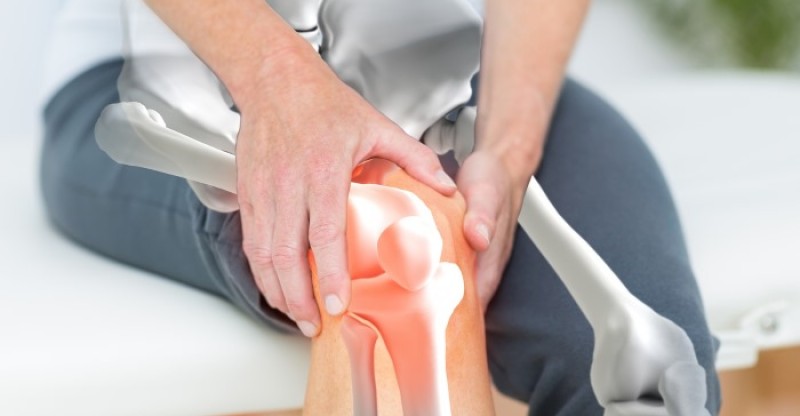16 Natural Remedies Joint Stiffness
Many people associate joint pain and stiffness with getting older.
In reality, this pain and stiffness can happen at any age.
In this article, you will learn vital information to help identify why the pain occurs, how to avoid the pain, and remedies for the pain when it does happen.
You should read until the end to ensure a complete understanding of this subject.
Why Does Joint Stiffness Occur?
The first step in achieving a complete understanding of joint stiffness is to grasp why it occurs.
As you age, it is normal to experience stiff joints.
This happens because the years of use take a toll on both your muscles and your joints.
When you first wake up in the morning, you may feel stiff because when you lie down for hours, the fluid in your body is reduced.
Moving joints need this liquid, and without it, they may be a little stiff.
Inflammation can also cause pain and stiffness in your joints.
When inflammation and suffering accompany stiffness, walking and standing may be very difficult.
Each of the above can impact your mobility by different degrees.
The stiffness may be mild, caused by sitting or lying down for extended periods of time.
This slight stiffness typically only affects your mobility for a little while, but if the stiffness is more severe, your movement will be affected more.
It is important to remember that stiff joints can be caused by a variety of other conditions besides age.
These conditions include lifestyle factors, lupus, bursitis, arthritis, and a variety of others.
Gout
Many of the causes of joint hurt are gradual, but gout comes on all at once.
Gout can appear while you sleep, which makes the joints especially stiff and sore when you awake.
When sudden and severe pain and tenderness happen in any joint, it is possibly caused by gout.
Typically, the first joint to be affected by gout is the big toe.
Gout is a type of arthritis that affects more men than women.
However, after menopause, a woman’s chance of developing gout increases.
Gout can be treated, but you will still experience periods of symptoms.
Bone Cancer
Stiff joints are rarely caused by bone cancer, but the possibility is there.
A person who has bone cancer may experience bone pain, joint hurt, swelling, or sensitivity.
However, every person may not have pain when he or she has bone cancer, which is why it goes untreated.
Bone cancer is treatable, but full recovery depends on numerous factors such as size, type, and location of the cancer.
Bursitis
The ligaments, muscles, and bones have small fluid-filled sacs called Bursae that provide a cushion.
When these sacs become swollen, you have bursitis.
Bursitis can cause pain and stiffness in the affected joints.
Bursitis is possible in any joint but is common in the larger joints such as the elbow, hip, and shoulder.
It is also commonly found in the big toes, ankles, and knees.
Bursitis can be treated easily by resting the affected area for a while.
This treatment may include a decrease in physical activities and immobility.
This time allows the bursae to heal.
Rheumatoid Arthritis (RA)
Rheumatoid Arthritis is commonly referred to as RA.
Arthritis is the leading cause of joint pain, and RA is the second most common form of arthritis.
RA affects over 1.5 million Americans, with people showing symptoms typically between the ages of 30 and 60 years old.
RA is categorized as a chronic inflammatory disorder and an autoimmune disease.
In an autoimmune disease, the immune system attacks healthy parts of your body.
Eventually, RA will cause bone erosion and joint deformity.
Unfortunately, RA is not curable, so the symptoms never entirely go away.
Also, the disease continues to advance even with treatment.
Osteoarthritis (OA)
The most common form of arthritis is osteoarthritis, also known as OA.
This type is referred to as degenerative arthritis, and affects almost 27 million Americans; it develops commonly in people who are over the age of 65.
OA is caused by wear on your joints when cartilage is worn away.
Cartilage protects the bones in the joints, and over time it no longer can provide the same amount of protection, which causes joint pain and stiffness.
OA commonly affects the knees, back, or hips, and can influence any other joints in the body.
Pain, swelling, and cracking joints are all symptoms of OA.
As with RA, OA continues to worsen, which causes the bones to break more easily and bone spurs to develop.
When the cartilage completely disappears, bones rub against other bones, causing extreme pain.
However, OA can be treated in a variety of ways, which includes lifestyle changes and surgery.
Lupus
The final condition discussed in this article is Lupus, which is also an autoimmune disease.
Similar to RA, Lupus attacks the joints, which can cause you to feel pain, swelling, and stiffness.
Lupus is a tricky disease to diagnose because it shares or mimics symptoms associated with other conditions.
There is not a cure for Lupus, and it will continue to worsen as time passes.
Treatment will help control the symptoms, but will not get rid of them all.
How to Avoid Joint Stiffness
While the above diseases and conditions cannot be avoided, there are ways to help decrease the possibility of your joints from being stiff, even if it is associated with age.
You can try the following five ideas to help prevent stiffness and pain in the joints.
- Exercise
Regular exercise increases your joint strength and flexibility.
This strength and flexibility can help avoid the need for muscle and joint pain relief.
- Rest
Rest allows the joint and muscle to repair itself naturally.
Rest also contributes to restoring the body’s energy, which can help prevent injuries.
- Alternative Practices
If you participate in alternative medical practices such as acupuncture and Bikram yoga, the range of motion of your joints will be enhanced, which also helps prevent injuries.
- Diet
Regulating diet can help prevent pain and stiffness in joints.
Herbal mixtures can also provide ingredients to help avoid hip and knee joints’ swelling and pain.
- Massage
After working the joints and muscle, a massage will help prevent them from tightening and causing pain and stiffness.
Adding a topical menthol rub to a massage will also reduce the chance of developing soreness.
Joint Stiffness Remedies
While prevention is key, stiffness and joint pain may still happen.
When stiffness and suffering do occur, a variety of remedies is available to alleviate the pain.
Epsom Salt
Regardless of the cause, Epsom Salt can provide relief for joint hurt.
Magnesium sulfate is the main ingredient in Epsom Salt.
This natural mineral has been relieving pain and stiffness in joints for a long time.
Epsom Salt has a tremendous amount of magnesium which helps alleviate pain.
Magnesium will be discussed in detail later in this article.
However, first, you need to know how to use the Epsom Salt properly.
Fill the tub or a large bowl with warm but not hot water. If using a bowl, add about ¼ to ½ cups of Epsom Salt.
If using a standard-sized bathtub, you should add about 1½ to 2 cups of the salt.
Once the salt is completely dissolved, soak the sore joint to help relieve pain and swelling.
Do not use Epsom Salt in extremely hot water or a hot tub without asking a doctor.
Magnesium
Epsom Salt has magnesium, but this nutrient is more efficient if it is taken orally.
You can apply magnesium in an oil form also, which can be absorbed to relieve pain.
As previously stated, it is better to change your diet to include foods high in magnesium such as legumes, nuts, and dark leafy greens.
You can also take supplements to help increase your magnesium levels.
Your body cannot make magnesium, but you use it for over 300 biomechanical processes in your body.
Magnesium is responsible for relaxing muscles and nerve endings, which makes it work as a joint medicine.
Magnesium also helps your heartbeat and helps your bones to mineralize.
And magnesium can alleviate arthritis pain.
Studies have proven that people who have diets high in magnesium have stronger bones with higher densities.
It is important to remember you can take magnesium supplements, but the best way is to eat foods rich in magnesium.
Turmeric and Ginger Tea
Turmeric has received a lot of positive attention recently.
The active ingredient in turmeric is curcumin. Curcumin is an antioxidant.
Turmeric also helps to lower two of the enzymes that cause the inflammation associated with arthritis.
Both turmeric and ginger have anti-inflammatory properties that can help relieve the pain associated with osteo- and rheumatoid arthritis.
Turmeric and ginger can be taken as a supplement, or you can make tea.
This tea is a bit spicy but can be enjoyed twice each day.
You need two cups of water, ½ teaspoon of ground ginger, ½ teaspoon of ground turmeric, and honey, to make this spicy tea.
You should bring the water to a boil before adding the turmeric and ginger.
After adding these two ingredients, you should allow the water to boil for an additional ten to fifteen minutes.
Remember to strain the water and add honey before you drink this amazing tea.
White Willow Tea
Another excellent tea to provide muscle and joint pain relief is white willow tea.
Years before aspirin was created, people used white willow bark.
The first mention of white willow bark can be found in the 5th century BC when Hippocrates (the Greek physician) discussed its healing properties.
Sometime in the 1800s, it was discovered that white willow bark contained salicin, its active ingredient.
The active ingredient in aspirin is acetylsalicylic acid.
The body converts salicin into salicylic acid, which functions similarly to acetylsalicylic acid.
However, this conversion happens after the white willow bark passes through the stomach, which reduces irritation and side effects.
You can take two teaspoons of powdered or chipped white willow bark and add it to boiling water; allow the water to continue to boil for at least fifteen minutes.
You then remove this mixture from the heat and allow it to steep for thirty additional minutes.
You can add honey and lemon for more flavor.
It is recommended to drink this tea twice a day or take a capsule supplement to help with pain and stiffness.
Fish Oil Supplements
Another useful supplement is fish oil supplements.
In 2012, a group of researchers found that if you take fish oil, you will report fewer episodes of having stiffness and pain when walking.
This relief can be found in two types of unsaturated fats which are found in fish oil.
These unsaturated fats are DHA (docosahexaenoic acid) and EPA (eicosapentaenoic acid).
Both of these fats have been proven to reduce inflammation.
Inflammation is what causes swelling and pain in joints.
Fish dishes such as salmon and Halibut also contain omega-3 fatty acids and will help reduce inflammation.
When reading the label on bottles of fish oil supplements, you can determine how many milligrams of omega-3 fatty acids are in each capsule.
Typically, the dosage should be at least 300 milligrams each day.
It is important to remember to speak with your doctor before taking fish oil supplements because they can interfere with other prescription medications.
Flaxseed
Flaxseed comes from the flax plant, which contains omega-3 and omega-6 fatty acids.
The omega-3 fatty acid is alpha-linolenic acid (ALA).
ALA is similar to EPA and DHA omega-3 fatty acids, because it may help reduce inflammation and stiffness in the joints.
Flaxseed comes in whole seeds, ground meal or flour, pills, or oil.
The whole seeds must be ground or crushed to help make available the healthy fats.
The body cannot digest and break down whole flaxseeds to receive the healthy fats.
You should also be aware that while ground flaxseed has ALA, flaxseed oil has much more.
You can buy flaxseed oil in capsules, or as a liquid in a bottle.
If you are using ground flaxseed, the recommended dosage is 30 grams or one ounce.
The dosage for tablets comes in 1,000 mg to 1,300 mg, and with flaxseed oil, you should take one to three tablespoons each day.
Another important note about flaxseed is the Arthritis Foundation supports the use of it to ease the symptoms of rheumatoid arthritis.
Hot and Cold Therapy
When you experience chronic pain from arthritis, a heating pad or an ice pack can help alleviate pain when joints hurt.
Either temperature extreme can be beneficial in helping to reduce stiffness and pain in the joints.
However, you have to decide if hot or cold is the best choice.
If the joint is stiff, sore, or tense, heat can help relax it.
Heat can also increase blood flow to make circulation better.
If the pain is a burning sensation, cold will help cool the area and numb it.
The cold will also reduce inflammation, helping the joint to reduce back to normal size.
You should never put heat on a hot and irritated joint.
You also should never put cold on a stiff joint that is having trouble moving appropriately.
Whichever temperature you decide to use, apply the ice pack or heating pad for at least fifteen minutes, but not more than thirty minutes at one time.
You can use the ice pack or heating pad several times a day.
Steroids
As a last resort, a doctor may prescribe steroids as a joint medicine.
Steroids are an incredibly powerful anti-inflammatory.
They are commonly used to treat a variety of types of conditions, which includes rheumatoid arthritis and Lupus.
Steroids are used because they are effective in treating the inflammation and swelling in the joints caused by these conditions.
Corticosteroids are particularly useful when treating inflammation.
However, steroids are not effective in the advanced stages of arthritis.
Steroids also lose their effectiveness the longer you take them.
And steroids can have a variety of side-effects when taken as a capsule, or long-term.
For these reasons, doctors will inject the steroid directly into the affected joint.
A physician may also use other medications with steroids, and use a lower dosage of the steroid.
Finally, you must remember that relief will be short-lived when using steroids, so it may not be worth the side-effects.
Extra Virgin Olive Oil
With extra virgin olive oil’s consistency, many people already think it would be perfect to lubricate your joints.
Not only can you use it to lubricate your joints, but it will also ease arthritis pain.
One of the primary compounds of extra virgin olive oil is oleocanthal.
Oleocanthal is similar to Advil, which inhibits the enzymes COX-1 and COX-2.
These two enzymes are referred to as the inflammatory proteins.
Studies have shown that the effects of 1½ tablespoons of extra virgin olive oil are equal to those of 200 mg of ibuprofen.
When olive oil is heated, the oleocanthal is destroyed, which means the oil must be cold-pressed to retain its healing properties.
Another critical factor when determining levels of oleocanthal is the ripeness of the olive when it is pressed.
These facts are why extra virgin olive oil must be used for joint pain.
You can take the olive oil orally to reap benefits; however, it contains a lot of fat, so it may be better to replace butter with it when cooking.
You can also rub two to three tablespoons of oil onto the sore joints two times a day.
Exercise
As previously stated, exercise can help prevent stiffness and pain, but it can also contribute to lessening these same two things.
It is unpleasant to consider exercising when you are in pain, but exercise is critical for those who have stiffness, arthritis, or pain.
Excessive weight puts pressure on your joints, which can cause pain and stiffness.
Exercise can help control your weight. Exercise also helps strengthen muscles and lubricate the joints.
When you exercise, the synovial fluid surrounding the joints is warmed and becomes more viscous.
A variety of joint-targeted exercises can be performed to assist in heating this liquid.
These exercises include stretches that mainly target joints to get rid of stiffness.
Another idea is to begin walking at a brisk pace for fifteen minutes each day.
The most important action to do is to make sure to get up and move every single day to help alleviate pain in your muscles and joints.
Dandelion Leaves
Dandelion leaves are high in Vitamin A and Vitamin C.
These two vitamins support the repair of damaged tissue.
They also support the liver when it removes a variety of toxins from your blood.
Dandelion leaves also have linoleic and linoleic acid, which have anti-inflammatory properties.
Linoleic also helps the body to produce prostaglandins.
Linoleic is one of the essential fatty acids that help to regulate the immune responses from the body.
It also supports the reduction of inflammation.
You can benefit from dandelion by making a salad or tea.
You can take three teaspoons of fresh leaves, or one teaspoon of dried leaves, and put them in one cup of boiling water.
This tea must be strained before you drink it.
This tea is not for everyone because it is extremely bitter.
A salad can also be made with dandelion leaves by adding just a little olive oil as dressing.
Blackstrap Molasses Drink
For many years, people have been using blackstrap molasses as a home remedy for arthritis pain.
It has minerals such as magnesium, potassium, and calcium that support healthy joints.
If you wanted to make blackstrap molasses, you would have to boil sugar syrup at least three times.
It has numerous nutrients that refined sugars do not have.
The molasses must be boiled three times to help release these nutrients.
Luckily, blackstrap molasses can be purchased at your local grocery store.
Blackstrap molasses has constituents that help strengthen bones while regulating muscle and nerve function, which makes it an excellent dietary supplement.
You can easily get your daily dose by combining one tablespoon of blackstrap molasses with one cup of warm water.
The water should be warm but not hot because it affects the healing properties of the tea.
Beware though; blackstrap molasses can have a laxative effect.
Cayenne ‘Capsaicin’ Ointment
You can make cayenne ‘capsaicin’ cream by mixing three tablespoons of cayenne powder with one cup of your favorite oil (almond, grapeseed, olive) and placing it in a double boiler for ten to fifteen minutes.
After this time, you need to add a half of cup of beeswax to the pan and stir until melted.
You then have to chill for ten minutes, stir it, and then cool for an additional ten minutes.
Finally, the mixture needs to be whisked, and then it is ready to be used.
The capsaicin in the cayenne pepper works like an OTC pain reliever because it blocks Substance P.
Substance P is present when pain signals are transmitted to your brain.
This rub diminishes pain to mere discomfort.
This ointment is only a temporary fix and must be used sparingly.
It affects how your brain understands pain signals, which might be a bad idea to manipulate over a long period.
Peppermint Eucalyptus Oil Blend
Neither peppermint nor eucalyptus has any effect on the course of arthritis, but both have analgesic properties.
When combined, peppermint and eucalyptus provide a cooling sensation that will override any discomfort you feel.
They also create a soothing feeling that will lessen the pain associated with arthritis.
To make the perfect blend of peppermint and eucalyptus oil, you should combine ten drops of peppermint oil, ten drops of eucalyptus oil, and one to two tablespoons of a carrier oil (almond, grapeseed, or olive).
The oil that is created from these two oils can be used two to three times a day to help with inflammation and pain in your joints.
It is also possible to use this fantastic combination every time your joints ache.
However, it is important to remember that when you use this blend, you are treating the symptoms of arthritis and not the actual disease.
This fact means that arthritis will continue to advance, even though the pain has lessened.
Juniper Berry Tea
You are probably shaking your head at yet another tea, but in 2009, the ‘Journal of Ethno Pharmacology’ discovered that juniper berries have terpinen-4-ol.
Terpinen helps to suppress monocytes, which are a type of white blood cells.
These white blood cells are a part of your immune system that responds to inflammation.
When you have rheumatoid arthritis, your immune system attacks your joints, causing inflammation and a variety of other symptoms.
If you take juniper berries each day, the terpinen content will reduce the discomfort from inflammation.
The only types of juniper you should use to make tea are the prickly and common juniper varieties to ensure effectiveness.
The juniper berry tea should not be taken if you are pregnant.
The tea can easily be made by adding one tablespoon of dried juniper berries to one cup of boiling water.
The berries should soak for at least twenty minutes before straining.
Pectin and Grape Juice
Pectin comes from the cell walls of plants.
It is a water-soluble carbohydrate-type substance.
Pectin is what keeps the cell walls of the plant together, and helps make fruit firm when it is ripe.
Often, it is taken from fruit to be used in jams and jellies as a setting agent.
When pectin is combined with grape juice, it becomes a widely-used home remedy for arthritis.
It has been suggested that pectin and grape juice can help the synovial tissue become more elastic.
This change helps lubricate the joint, also.
Even though there are not a lot of studies associated with the benefits of pectin, many people agree that the combination of pectin and grape juice provides a massive amount of pain relief.
You can combine one tablespoon of pectin and eight ounces of grape juice to create an amazing drink that can be taken one to two times a day.
When to See a Doctor
Typically, a gradual onset of joint pain is rarely an emergency and can be managed by using the above individual remedies.
However, if the pain increases or lasts for longer than five to seven days, you should schedule an appointment with your doctor.
Many symptoms are signs of a more serious condition, so you may want to seek medical advice for any of the following symptoms:
- any severe pain in the joints or muscles
- extreme or rapid swelling
- unusual and extreme redness around the area
- the joint is tender and hot when touched
It is also important to see a doctor if you have injured your joint and you see any of the following signs:
- the joint looks or feels deformed
- the joint refuses to move
- the joint experiences an intense amount of pain that cannot be controlled
As you age, pain and stiffness in your joints are common. However, they can also be a sign of other conditions or diseases.
The only way to be sure of what causes the pain is by a physical exam.
It is also important to have an accurate diagnosis to determine the best treatment.
With a diagnosis, it reduces the chance of the pain reoccurring and will help ease any symptoms.
Conclusion
As you age, pain and stiffness develop in your muscles and joints.
A variety of conditions can also cause you to feel this pain and stiffness.
Some of these most common conditions are arthritis, Lupus, and bursitis.
While many of these conditions do not have a cure, this article has provided over fifteen individual remedies to help control the swelling, inflammation, soreness, and stiffness.
However, you must go to a doctor if you experience certain symptoms, to ensure you are using the correct treatment.
FDA Compliance
The information on this website has not been evaluated by the Food & Drug Administration or any other medical body. We do not aim to diagnose, treat, cure or prevent any illness or disease. Information is shared for educational purposes only. You must consult your doctor before acting on any content on this website, especially if you are pregnant, nursing, taking medication, or have a medical condition.
HOW WOULD YOU RATE THIS ARTICLE?





